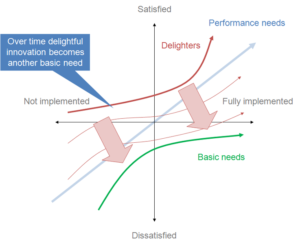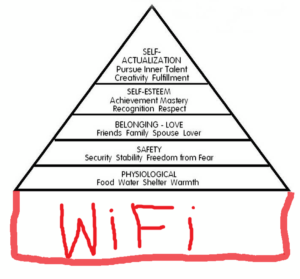Why I think it could be useful and how it could be used
First, a disclaimer.
People can and do spend lifetimes working in this area. I have not done so. I am almost certainly cutting corners or just flat out being wrong on the internet. But I think that what I’m turning out is useful for a UX context. I may be doing a disservice to the techniques by dumbing them down or removing some rigour that would be present in a more proper application within the context from which they originate. For this application, this is acceptable. For other applications – particularly those relating to Health Psychology, you should seek better advice.
If you’re after a UX research technique to help you understand subjectivity and viewpoint, this might be helpful or interesting to you. If it is, then we’re good – but you might benefit from reading a little more about it.
What is Q-Methodology?
It’s a qualitative research technique, originally from psychology (particularly health psychology) which is used for understanding subjectivity. While it is a qualitative method, it produces numerical data, leading to it sometimes being referred to as a qual-quant methodology.
It helps reveal both consensus and divergence from consensus within a group of subjects. It characterises both that consensus and the divergence from it.
What is subjectivity?
Consider subjectivity as an opposite of objectivity. If you are objective, you have taken your viewpoint out of the equation. If you have not taken your viewpoint out of the equation, then you are exhibiting subjectivity. Objectivity is an absolute, but subjectivity is not – it is individual to a person. Understanding subjectivity means understanding a user’s attitude regarding a topic.
Why is understanding subjectivity useful to us?
When we are talking to users, we want to be objective, but we want them to be subjective. We want to understand what their subjectivity is, what it means to them and what it should mean to us.
Consider where you have sent out a survey and two users have returned almost identical responses but when you interview them you discover that their identical responses are hiding wildly different concerns, interests or goals. They might be doing the same things with different motivations, or they might have encountered the same problems but have felt wildly different impacts from them. They might both say that one flow is bad, but have very different reasons for thinking so.
The difference in these situations is often not in what they needed to do or how they achieved it (or failed to), but in their subjectivity – their attitude and viewpoint.
Terminology
Because I heard of this approach from a Health Psychology professor – albeit in an ad-hoc, unofficial fashion – I’ve researched it using sources arising from that field. I’m using (or perhaps abusing) Health Psychology practices and terminology, which is not always the same as is used in UX or software related fields. So, here’s a bit of a glossary:
Cohort – The body of individuals being interviewed.
Concourse – The wider body of discussion – this could be made up of notes, recordings and quotes from interviews, excerpts from online communities, support tickets or any other body of user-created statements.
Statements (aka. Q-Statements) – A representative sample set of short phrases, drawn from the concourse. The subjective true-ness or right-ness of these are compared via a Q-Sort to understand subjectivity.
Subjectivity – see the introduction.
Q-Sort – A specific form of card-sort exercise, using the statements and performed individually with some or all of the cohort. This is not the same as a QSort in software development terms, which makes googling a little bit harder.
How an interview series works
A quick summary
- Build a concourse or find a pre-existing one
- Prepare statement cards
- Prepare the q-sort matrix
- Run the interviews
- Analyse the data
Step one – build a concourse or find a pre-existing one
If there is no pre-existing concourse, then a two-part session is possible – the first part should be a group discussion with several subjects about the matter under discussion, from which a set of representative statements can be drawn.
If interviews have been conducted on this subject in the past, notes or recordings from those may be used, although it is entirely possible that the subjectivity of your new interviewees may not match that of those interviewed previously.
Step two – prepare statement cards
The facilitator should prepare a set of statement cards, which should be drawn directly from the concourse. The number of statements can vary a lot – a smaller set of statements will lead to a faster interview process, but you also may not gain as much insight. You should aim somewhere between 10 and 100 cards.
- Statements should be phrased as declarative statements. Some examples:
- “It is the case that…”
- “I must be able to…”
- “I can…”
- “It is important that…”
- “It is good when…”
- “It is bad when…”
- One statement per card, one card per statement
- The cards should all be uniquely numbered.
- The same cards should be used in each session in a series
When creating statements, it is better to start fresh, but you could take typical “As a [p], I can do [x] to achieve [y]” story titles and rephrase them as “I can do [x] to achieve [y]” or even two statements – “I can do [x]” and “I can do [y]” separately.
The rephrase to remove the role is important, as including the role would affect how the statements are sorted. This would provide a better-than-nothing set of statements to work with.
Likewise, separating the reason or end goal from the specific actions taken towards it lets you understand where subjects differing viewpoints may result in different actions for the same goal, or the same action for different goals.
Step three – prepare the Q-Sort matrix
At the start of each interview session, the facilitator should prepare a Q-sort grid. The configuration may vary, but the following will usually be true:
- It is a funnel-shaped symmetrical grid able to accommodate all the statement cards
- There will usually be more than three columns – typically five, seven or nine.
- The columns will have different heights to accomodate different numbers of cards each.
- The central column will accomodate the most cards, outer columns the least, with a steady decline moving outwards. Often modelled on a normal distribution.
- The columns will be labelled across the top and given a value.
| Number of columns | Example Leftmost label | Example Rightmost label |
| 7 | Least true / most false (-3) | Most true / least false (+3) |
| 5 | Least accurate (-2) | Most accurate (+2) |
| 9 | Strongly disagree (-4) | Strongly agree (+4) |
Step four – run the q-sort interview sessions
- Run a one-on-one q-sort interview for each subject in the cohort
- The facilitator should explain that the exercise is about understanding viewpoint, and as such there are no right or wrong answers. The statement cards are also a talking point and may be discussed or talked around. These sessions can be recorded as if they were any other interview – the cards and sorting exercise provide a framework for the interview as well as being an act of research on their own.
- The participant should sort the cards into the matrix, depending on how well the cards fit their understanding, interests or needs. If the session is being recorded with audio-only, the facilitator should ensure that the cards being discussed are each read aloud, and their eventual placement is made clear for the recording.
- After each session, the facilitator should document which cards were placed into which columns. They should do this by creating a record for each participant. That record should be a list of {card number, column score} pairs.
Step five – analyse the data
After the interviews, the facilitator can perform some simple analysis with (for example) excel. There are several useful things which can be produced:
Heatmap – consensus
- create a square grid with card numbers on one axis and column values on the other.
- Fill each cell with the percentage of users who placed that card in that column.
- Convert numerical values to a colour shade to produce a heat-map.
- Use the heatmap to spot commonality or difference of viewpoints, and therefore identify consensus or an absence of consensus.
Fingerprint – individual viewpoint
- For each participant, create a rectangular grid with card numbers on one axis and column values on the other.
- Fill any cells where a participant matched card number and column number.
- Overlay one fingerprint over another to identify commonality/difference of viewpoint.
Heatmap / Fingerprint comparison
Overlay a Fingerprint over the overall heatmap to identify where it varies or matches any consensus.
Fingerprint grouping
Identify similar fingerprints within the cohort and use these groups as a basis for persona creation – similar fingerprints imply a similar viewpoint.
- Treat each fingerprint as a vector, determine the “distance” between fingerprints by subtracting one from the other.
- The shorter the distance, the closer the subjectivities.
- The greater the distance, the more different the subjectivities, and the greater likelihood that they should be different personas.
- Two users might have same goals, same day-to-day activities, but have different subjectivities. This would indicate they are a different persona who happens to be in a similar role, but who operates in a very different way with different priorities or in a very different space.
Further analysis?
Data scientists and statisticians can then apply tools like Principal Component Analysis or other Factor Analysis to the results if they feel the need to do so. This may help with further definition of the most significant differences between uncovered subjectivities.


Recent Comments